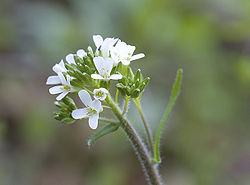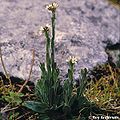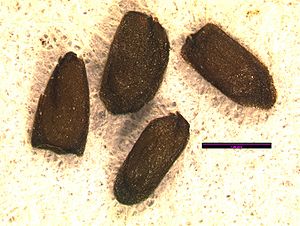Difference between revisions of "Arabis eschscholtziana"
(→Taxonomy) |
|||
| Line 17: | Line 17: | ||
== Description == | == Description == | ||
| + | General: Biennial from a simple crown and strong taproot, the 1-several simple stems 1.5-10 dm. tall, pubescent at the base with stiff, simple hairs, becoming glabrous above. | ||
| + | Leaves: Leaves mainly cauline, the basal oblanceolate, 2-8 cm. long, narrowed to short, winged petioles, mostly glabrous on the upper surface, the lower surface purplish, pubescent with stiff, simple hairs; cauline leaves alternate, 5-15, remote to overlapping, sessile and auriculate, ovate-lanceolate to narrowly lance-elliptic, 2-12 cm. long and up to 3 cm. broad, pubescent as the basal leaves or the upper glabrous. | ||
| + | Flowers: Inflorescence of many-flowered, simple to compound racemes; pedicels 6-9 mm. long; sepals 4, 3-5 mm. long, glabrous, the outer 2 gibbous-based; petals 4, white to cream or pinkish, 4-9 mm. long; stamens 6; style 0.5-1 mm. long. | ||
| + | Fruit: Siliques glabrous, 3-8 cm. long and 1-2 mm. broad, 1-nerved, strictly erect; seeds in 1 series, 1.5-2 mm. long, wingless or with a wing up to 0.3 mm. broad. | ||
== Bloom Period == | == Bloom Period == | ||
Revision as of 07:31, 14 May 2012
Common Name Hairy rockcress
Abbreviation Code: ARHI
First overview block: Scientific Name, Synonyms, Family, English Names, Other Names
Contents
Taxonomy
- Kingdom: Plantae
- (unranked): Angiosperms
- (unranked): Eudicots
- (unranked): Rosids
- Order: Brassicales
- Family: Brassicaceae
- Genus: Arabis
- Species: A. hirsuta
Description
General: Biennial from a simple crown and strong taproot, the 1-several simple stems 1.5-10 dm. tall, pubescent at the base with stiff, simple hairs, becoming glabrous above. Leaves: Leaves mainly cauline, the basal oblanceolate, 2-8 cm. long, narrowed to short, winged petioles, mostly glabrous on the upper surface, the lower surface purplish, pubescent with stiff, simple hairs; cauline leaves alternate, 5-15, remote to overlapping, sessile and auriculate, ovate-lanceolate to narrowly lance-elliptic, 2-12 cm. long and up to 3 cm. broad, pubescent as the basal leaves or the upper glabrous. Flowers: Inflorescence of many-flowered, simple to compound racemes; pedicels 6-9 mm. long; sepals 4, 3-5 mm. long, glabrous, the outer 2 gibbous-based; petals 4, white to cream or pinkish, 4-9 mm. long; stamens 6; style 0.5-1 mm. long. Fruit: Siliques glabrous, 3-8 cm. long and 1-2 mm. broad, 1-nerved, strictly erect; seeds in 1 series, 1.5-2 mm. long, wingless or with a wing up to 0.3 mm. broad.
Bloom Period
Distribution
Habitat
Uses
Propagation
Photo Gallery
References
| FloweringTime | April - June |
Seed
Seed sample from: 2011
Average Measurement: 1.6 x 0.9 x 0.2
Measurement Range: L: 1.3 - 1.75, W: 0.6 - 1, D: 0.1 - 0.3
Features
Shape: Seeds flat, somewhat winged, especially at hilum end and opposite. Accumbent cotyledons and sulcus present.
Color: Seed dark brown in center, darkening to black at the winged edges. Hilum inconspicuous.
Surface: Texture is bumpy, and seed is somewhat lustrous.
Latitudinal Cross Section: elliptical ![]()
Longitudinal Cross Section: elliptical ![]()
Basic Explanations and Assumptions:
The dimensions for the seeds are length x width x depth. The location of the hilum is used as the base of the seed, and the length is measured from hilum to the opposite apex. Where a style is present, the length is measured from the hilum to the bottom of the style. Width is measured at a right angle to the length at the widest part. Depth is measured at a right angle to the intersection of height and width lines.
Measurements included are the mean average for each measurement of ten separate seeds.
All measurements in millimeters unless otherwise noted.





